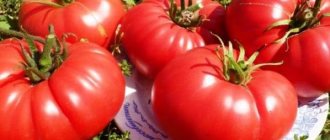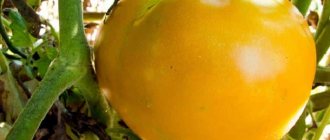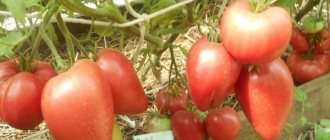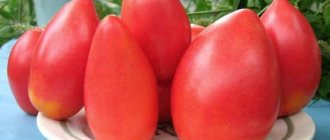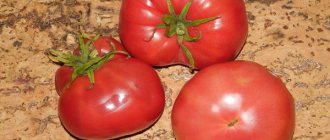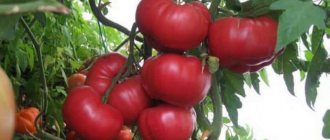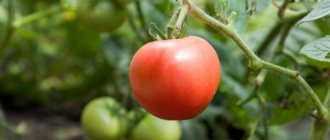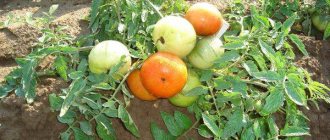A tomato with the caramel name Lollipop from the agricultural company Biotechnika is one of the universal varieties that does not require constant attention. Designed for cultivation in open ground under temporary shelters or in seasonal unheated greenhouses.
| Height | Landing location | Ripening time | Fruit color | Fruit size | Origin | Fruit shape |
| Medium height | Greenhouse, Open ground | Early ripening | Reds | Small | Variety | Plum-shaped or oval |
Description and characteristics of the variety
Lollipop tomatoes ripen 90-95 days after germination.
Suitable for growing both in greenhouse conditions and in garden beds.
Description of the variety:
- plant of semi-indeterminate type;
- the bush is not standard, 0.5-0.65 m high (when planted in greenhouses), and 1.2-1.5 m in open beds;
- leaf dark green, potato type;
- inflorescences of a simple type, formed with an interval of 2-3 leaves;
- each one bears 8-12 tomatoes;
- the fruits are red, small in size, plum-shaped or oval in shape;
- the tomato skin is thin, durable, and does not crack;
- the pulp is dense;
- the taste is excellent, sweet.
The yield of Lollipop tomatoes is up to 3 kg from each bush. Weight of 1 medium berry – 40-50 g.
The use of fruits is universal, that is, they can be eaten fresh, processed and canned, including in jars. In the photo below you can see what representatives of the variety look like.
Description of the tomato variety Lollipop, features of cultivation and yield
The main feature of the variety can be understood immediately from the name of the plant; gardeners often call it “sweetie”. Tomato Lollipop got its name due to the small size of the tomato and its unusual taste, characterized by increased sweetness. At the same time, many gardeners, speaking about the sweetness of the variety, note the absence of a sugary-sweet taste and the presence of moderate sugar content. In this regard, the fruits have a so-called conditional sweetness.
The variety belongs to the category of universal varieties with early ripening and is suitable for growing in greenhouse conditions and in open ground.
The advantage of the plant is the massive simultaneous ripening of fruits. Compact, small-sized tomatoes look beautiful on the plant's cluster and are ideal for canning and pickling.
Description of fruits
When you first look at the plant, you will notice a large number of bunches of tomatoes. Description of tomatoes:
- have a characteristic elongated shape, reminiscent of a cylinder;
- ripe vegetables have a rich, bright red color;
- when fresh they have a characteristic tomato aroma;
- The average weight of one tomato varies from 40 to 60 grams.
The characteristics of the variety promise the first harvest on days 110–115 from the moment the first shoots appear. In the middle regions of the country, vegetables ripen in mid-August, and fruiting continues until mid-September. Due to the almost complete one-time yield of the crop, tomatoes are convenient for processing and preparing preparations for the winter period. An excellent quality of a tomato is its ability not to crack and retain its aesthetic appearance after exposure to hot liquid during canning.
A characteristic feature of the variety is the friendly tying of vegetables. The plant does not lose its ability to set even in conditions of elevated temperatures. Several small-sized tomatoes are formed on one brush at once, so it looks like a bunch. On average, 8 tomatoes are formed in one brush, but reviews from gardeners confirm the possibility of forming more fruits.
The variety is ideal for lovers of “calibrated” fruits.
Features of cultivation
The seeds are sold under the Biotechnika brand in paper packaging. Each kit comes with a small instruction manual describing the variety and growing characteristics, so gardeners always have valuable information at hand.
The plant is low maintenance and requires standard growing techniques. The time for planting seeds is determined depending on the climatic conditions of the region and the desired time of harvest.
Planting is carried out in the soil of a greenhouse structure or in an open area of soil. The average height of a plant bush varies from 50 to 100 centimeters. When grown in a greenhouse, the shoots are taller than when grown outdoors and can reach 2 meters. The shoots are compact and withstand the negative effects of environmental factors.
Despite their small size, the bushes need staking, as the bush turns out to be heavy. It is recommended to form shoots into 2 or 3 stems. If desired, you can form one main trunk and leave 2 stepsons, which allows you to get powerful shoots.
The plant requires regular monitoring of the shoots and their timely removal. This procedure provides the plant with a sufficient amount of nutrients, which promotes the formation and ripening of more tomatoes.
It is recommended to pinch the top of the bush at the end of the season. The plant demonstrates resistance to many tomato diseases. Tomato is demanding on lighting and moisture.
Sowing and growing seedlings
The process of growing seedlings begins with sowing seeds. It is carried out 1.5-2 months before transplanting into a greenhouse or on beds (approximately in mid-March).
First, they sort out the seeding material, calibrate it, separating the best ones - large and full-bodied seedlings. To do this, they are poured into a cup of water, and after a while the liquid is drained along with the floating seeds. The remaining ones at the bottom are poured for 20 minutes. potassium permanganate solution.
Afterwards, the seeds are washed with clean water, dried or germinated in a damp cloth until they hatch.
Seedlings are grown in pots. They are filled with soil mixture consisting of turf soil, peat, humus and coarse sand, taken in equal proportions. You can also use a universal substrate sold in stores. The seed sowing depth is 1-1.5 cm.
After planting, the pots are watered and transferred to a warm place (25˚C), with moderate lighting.
After sprouting, the containers are moved to the brightest part of the room so that the sprouts do not begin to stretch. The temperature is also reduced slightly. The best option where you can place plants is a windowsill.
Seedlings are provided with lighting for 10-12 hours a day (fluorescent or phytolamps are used if necessary).
Water the seedlings with warm, settled water at a frequency sufficient to keep the soil moist. It is convenient to moisten the soil first with a spray bottle, then with a small watering can with a nozzle.
Fertilize Lollipop tomatoes with complex fertilizers every 2 weeks. During the last 10 days of growing plants at home, they are hardened off - taken out of the room into the air, first for half an hour, but every day the stay time is increased.
By the time of planting in beds or greenhouses, Lollipop tomato seedlings should have 2-3 pairs of leaves and be at least 10 cm high, but not more than 20 cm.
Planting in the ground and caring for tomatoes
Plants are transplanted into open ground when the frosts have passed. In different regions, this time occurs approximately in the 2nd half of May - early August. They are planted in greenhouses 2-3 weeks earlier.
Lollipop tomatoes are placed in holes of 5-6 pieces. per sq. m. The depth of the holes should be slightly greater than the height of the pot in which the seedlings grew.
After planting in the ground, the tomatoes are watered and then mulched with any plant material. The mulch height should be approximately 5 cm.
Caring for Lollipop tomatoes is ordinary - they need watering, fertilizing, and, if necessary, treatment for pests and diseases.
Despite the fact that the variety is drought-resistant and can set fruit even in the heat, it is necessary to water the plants. Tomatoes should receive especially a lot of moisture after transplanting into beds and during the period of mass ripening of berries. The water should be settled and warm. Watering time is in the evening after sunset and early in the morning. After each moistening of the soil, if mulch is not laid on the surface of the beds, they need to be loosened.
Feed Lollipop tomatoes 3 or 4 times per season. The first time is before flowering, the second time is when the ovary appears, the third and fourth time is during the period of fruit ripening (with an interval of 2 weeks).
For feeding, you can use organic fertilizers in the form of an infusion of slurry (1 liter of organic matter per 10 liters of water or 1 to 15) 1 liter per bush and ash solution (1 tbsp per bucket), also 1 liter per plant.
Among mineral preparations, you can use the usual widely used saltpeter, urea, various potassium (chlorine-free) fertilizers, simple and double superphosphate. Dilute fertilizing solutions according to the instructions.
Since in a greenhouse the bushes of these tomatoes can exceed 1 m and grow until autumn, they are tied to supports. Form into 2-3 stems: leave the first 1 or 2 stepsons, from which additional stems are formed. All other shoots are removed as they grow, and by the end of the season the top is also pinched off. In open beds, bushes are tied up as needed.
The first harvest of Lollipop tomatoes is harvested 3 months after emergence. You can pick fully ripe and slightly unripe tomatoes and store them in a dry and cool place until processed.
Reviews from gardeners and summer residents about the variety
- Alla Efimova, 45 years old, amateur gardener:
I grew “Lollipop” in the garden. The tomato is delicious and smells very nice. The bushes bear fruit well and are very unpretentious. I am satisfied with the variety and will grow more - Lena Yakovleva, 38 years old:
I grew this variety, hoping that it would be good for pickling, but the tomatoes turned out to have thin skin, and this summer was rainy, the tomatoes cracked. And they are tasty, small, slightly larger in size than cherry tomatoes, and sweet. - Andrey D., 51 years old:
I’ve been planting this tomato for five seasons now. I buy seeds from Biotechnics. Very unpretentious, if you are lazy, you don’t even have to take stepson. The bushes are very beautiful, hung with neat “light bulbs”. Very good in pickling. Interestingly, according to some of my friends, green fruits in marinade are even tastier than red ones. I highly recommend this variety as an early, unpretentious and productive variety.
tomato Legend Tarasenko - description and characteristics of the variety
Similar varieties
Fans of early-ripening, medium-sized tomatoes with small and medium-sized fruits can choose the following varieties for growing in their beds:
- Valentina;
- Glacier F1;
- Don Juan;
- Cupid;
- Marisha;
- Sanka.
They, like the Ledenets tomato, are intended for cultivation in closed and open ground conditions in almost all regions of Russia.
Advantages and disadvantages of the variety
Lollipop tomatoes have characteristics that are valuable for amateur gardeners:
- precocity;
- average height;
- ability for friendly and long-term fruiting;
- resistance to diseases, heat;
- low maintenance requirements;
- productivity;
- Suitable for any climate.
The Ledenets variety has delicious sweet fruits with a characteristic aroma, suitable for fresh consumption and any canning. The skin is durable and does not crack from hot water, so tomatoes can be stored and transported.
One of the disadvantages is the need for formation and garter, but this is typical for most medium- and tall-growing tomatoes and is not a disadvantage of this variety only.
Description of the sweet tomato Lollipop and features of growing the variety
If a housewife is looking for sweetish tomatoes that can be canned whole, she should pay attention to the Lollipop tomato.
These are very tasty fruits that fit perfectly in a jar. One of the important advantages of the Ledenets variety is its unpretentiousness. He does not require special care, and also gets little sick. The tomato adapts to cool temperatures quite quickly, so it is easy to grow in many regions of the country. But it should be remembered that yields may suffer from severe cold, so in risky farming areas you should be very careful and use Lollipop tomatoes for growing in a greenhouse. In this case, you can get a bountiful harvest of delicious tomatoes, which will be enough for winter canning and for summer vitamin salads.
Fruit characteristics
Many gardeners are attracted to this variety primarily by the name. But don’t think that Lollipop tomatoes are very sweet, like candy. These fruits are more similar to sweets in form. As for the taste, this variety has a slight sourness, but it is insignificant.
At the same time, Lollipop tomatoes have a very pleasant aroma. Therefore, they are recommended to be added to salads and consumed fresh. If we compare these tomatoes with other varieties, then Lollipop is inferior to many in terms of sweetness, but among ordinary small fruits that are suitable for canning, it is one of the most delicious.
- The big advantage of Ledenets tomatoes is that they are small.
- Each tomato weighs about 35 g.
- 8 fruits appear on one hand at a time.
- They grow the same, so they look great in a jar.
Another advantage of this variety is their thick skin. It is not too hard, so tomatoes are good to eat fresh. Such tomatoes do not crack during transportation and after treatment with boiling water, and can be stored for a long time in a cool place.
